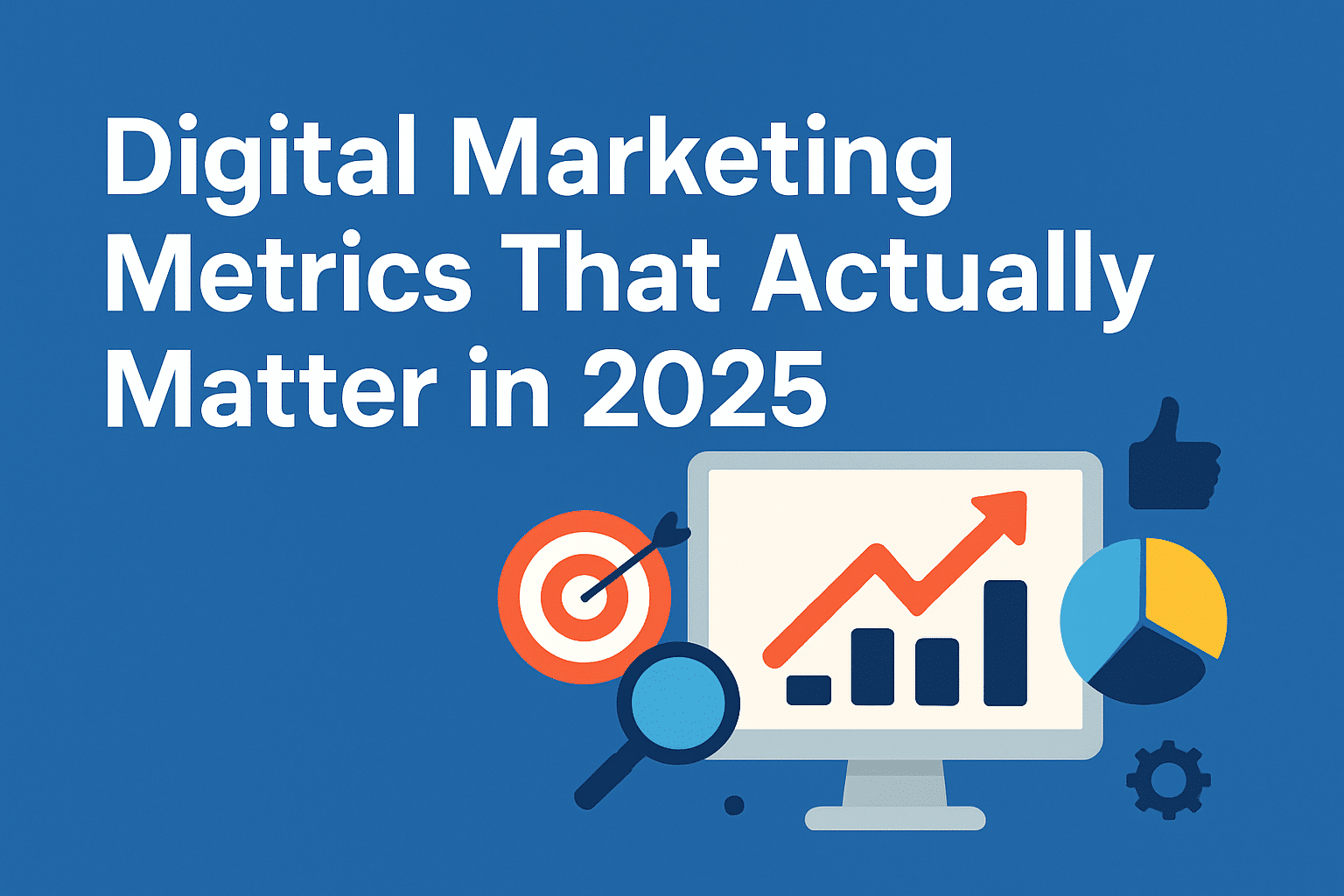This guide will empower you to establish a strong online presence from the ground up…

Digital Marketing Metrics That Actually Matter in 2025
Metrics can make or break your digital marketing strategy as you navigate the complexities of 2025. With an ever-evolving landscape, it’s imperative that you focus on data points that drive real results and improve your ROI. This guide will help you identify key performance indicators that truly matter, steering you away from vanity metrics that provide little value. Ready to elevate your strategy? Dive deeper into Vanquishing Vanity in the AI Age: The Digital Marketing … and gain insights that can transform your approach.
Table of Contents
Key Takeaways:
- Focus on customer engagement metrics, such as time spent on site and interaction rates, to better understand audience behavior and preferences.
- Use conversion attribution models to assess which channels and campaigns are driving the most valuable customer actions, ensuring optimized marketing strategies.
- Prioritize customer lifetime value (CLV) over short-term sales figures, as this will provide a clearer picture of overall business growth and profitability.
- Track brand sentiment through social listening tools to gauge public perception, allowing marketers to adjust strategies proactively in real-time.
- Emphasize data privacy compliance metrics to maintain consumer trust and ensure adherence to regulations, which is becoming increasingly critical in digital marketing.
The Shift to Customer-Centric Metrics
Your focus in 2025 has to pivot towards customer-centric metrics. This new approach emphasizes understanding the entire customer journey, rather than just individual interactions. By prioritizing metrics that relate to how your customers experience your brand, you amplify their value over time. This shift not only enhances customer satisfaction but also lays the groundwork for bolstering retention rates and driving sustainable growth.
The Importance of Customer Lifetime Value (CLV)
Understanding Customer Lifetime Value (CLV) has become non-negotiable in 2025. This metric provides a comprehensive view of the total revenue a customer can generate throughout their relationship with your brand. By calculating CLV, you can allocate your resources more effectively, tailoring marketing strategies that align with high-value customers, thereby maximizing profit potential.
Engagement Metrics That Drive Retention
In today’s digital landscape, metrics that reflect customer engagement have a direct impact on your retention rates. Metrics such as repeated site visits, social media interactions, and customer feedback ratings paint a vivid picture of how invested your audience is in your brand. By optimizing these metrics, you can create personalized experiences that resonate with customers, fostering brand loyalty.
Analyzing engagement metrics goes beyond basic statistics; it involves understanding customer sentiments and behaviors. For instance, if your average customer spends 20% more time on your site than last year, it indicates heightened interest and satisfaction. Using tools like heatmaps and session recordings, you can pinpoint which areas of your site keep customers engaged. This allows you to continuously refine your website and messaging, ensuring customers feel valued, ultimately increasing their likelihood of returning.
Navigating the Data-Driven Landscape
As the digital marketing terrain evolves, being adept at analyzing and utilizing data is paramount. You need to harness the vast amounts of information available to inform your strategies and drive engagement. From understanding consumer behaviors to predicting market trends, a savvy approach to data interpretation can set your brand apart. Leveraging the right tools and methodologies empowers you to stay relevant and responsive in a fast-paced environment.
The Role of Predictive Analytics
Predictive analytics serves as a game-changer in marketing, enabling you to forecast customer behavior with remarkable accuracy. By analyzing historical data patterns, you can identify trends and make data-driven decisions that enhance customer engagement and retention. Implementing models like machine learning allows you to tailor campaigns that resonate, significantly improving conversion rates and customer satisfaction.
Real-Time Data and Instant Decision Making
Access to real-time data transforms decision-making processes, allowing you to respond promptly to market dynamics. Utilizing platforms that provide up-to-the-minute insights equips you to monitor campaign performance and adjust strategies instantly. For instance, brands that employ real-time analytics can enhance customer experiences, as they can react dynamically to user interactions, leading to more personalized marketing efforts.
Imagine running a campaign and noticing a sudden spike in drop-off rates on your landing page. With real-time data at your fingertips, you can quickly identify issues, test variations, and implement changes on the fly. This proactive approach not only minimizes losses but also optimizes user experience, keeping potential customers engaged. Companies leveraging real-time analytics report an increase in conversion rates by up to 30%, showcasing the profound impact this capability holds for your marketing strategies.
The Impact of Artificial Intelligence on Metrics
Artificial intelligence (AI) is revolutionizing the way you track and analyze digital marketing metrics. By using sophisticated algorithms, AI can sift through massive datasets at lightning speed, uncovering trends and insights that were once difficult to identify. This not only enables you to refine your strategies but also enhances your overall marketing effectiveness. With AI’s ability to predict consumer behavior and optimize campaigns in real-time, metrics are becoming far more dynamic and actionable, making them integral to any successful marketing plan in 2025.
AI-Generated Insights for Performance Tracking
Utilizing AI for performance tracking transforms how you interpret data. Machine learning algorithms can analyze historical data to forecast future trends, allowing you to make more informed decisions. This means you gain a comprehensive understanding of which strategies yield the highest ROI, highlighting areas for improvement and tailoring your approach to enhance customer engagement.
Automated Reporting and Its Benefits
Automated reporting streamlines the data collection process, allowing you to focus on what matters most: deploying strategies that drive results. By automatically generating reports, you save time while gaining immediate access to critical insights, making it easier to pivot your marketing initiatives as needed. This not only boosts operational efficiency but also enhances your ability to present performance data quickly to stakeholders.
Automated reporting significantly enhances overall productivity within your team. Imagine having daily or weekly reports delivered straight to your inbox, outlining performance metrics and key insights without the manual effort of assembling data. You can quickly identify successful campaigns or areas needing adjustment, leading to faster decision-making and more agile responses to market conditions. With less time spent on compiling reports, your focus can shift toward strategic planning and creative execution, ultimately driving better marketing outcomes.
The Rise of Cross-Channel Metric Integration
With marketers increasingly utilizing multiple platforms, the integration of cross-channel metrics has become a priority. Cross-channel metric integration allows you to assess performance across various channels, creating a more cohesive marketing strategy. By observing how different platforms influence each other, you can enhance your campaigns and allocate resources more effectively. This holistic view not only informs strategic decisions but drives a more personalized approach to customer interactions.
Unifying Metrics Across Platforms
Unifying metrics allows you to compare performance seamlessly across different marketing channels. By establishing a standard measurement framework, you gain insights into how various touchpoints contribute to overall success. Whether it’s social media, email marketing, or SEO, having a common set of metrics enables you to identify which channels are synergizing and which ones need re-evaluation.
The Value of Omnichannel Customer Journeys
Understanding the value of omnichannel customer journeys leads to increased customer satisfaction and loyalty. When you track the paths customers take across multiple channels, you can identify pain points and opportunities for enhancement. Reports indicate that businesses adopting an omnichannel strategy can increase customer retention rates by up to 91%. This comprehensive approach not only provides a seamless experience but also fosters a deeper connection with your audience, ultimately driving better results.
Measuring ROI in a Complex Environment
Understanding ROI in a complex digital marketing landscape requires innovative strategies and a layered approach. As the marketplace evolves, the multitude of customer engagement channels makes it difficult to connect efforts with tangible outcomes. To hone your calculations, consider utilizing advanced tools that incorporate machine learning to analyze data and identify trends. For more insights, check out 17 Key Growth Marketing Metrics You Should Track in 2025.
Beyond Simply Tracking Conversions
Tracking conversions is just the tip of the iceberg. You need to evaluate the overall customer journey to get an accurate picture of your marketing effectiveness. Consider customer engagement metrics such as lifetime value (LTV), churn rate, and retention rates. These indicators highlight how well your brand resonates and builds loyalty among consumers, which is necessary for sustainable growth.
The Role of Attribution Models
Attribution models allocate value to different touchpoints in a customer’s journey, illuminating the paths that lead to conversions. By employing various attribution methods—linear, time decay, or even data-driven models—you can gain insights into how different marketing efforts contribute to your ROI. This understanding helps you prioritize investment in channels delivering the best return.
Utilizing the right attribution model can significantly shift your marketing strategy. For instance, a linear model evenly distributes credit across all channels visited, while time decay assigns more weight to touchpoints nearer to conversion. Data-driven models use algorithms to analyze historical data and assess which paths lead to the highest conversions. This advanced approach enables you to optimize your marketing spend by focusing on effective channels, ensuring every dollar invested works harder for you.
To wrap up
Following this, it’s crucial for you to focus on the digital marketing metrics that will truly influence your strategy in 2025. By concentrating on engagement rates, customer lifetime value, and conversion rates, you can gain deeper insights into your audience’s behavior and overall business performance. Understanding and analyzing these key metrics will empower you to make informed decisions and optimize your marketing efforts effectively, ensuring that your approach remains relevant and impactful in an ever-evolving digital landscape.
FAQ
Q: What are the key digital marketing metrics to focus on in 2025?
A: In 2025, some of the key digital marketing metrics to focus on include Customer Acquisition Cost (CAC), Return on Investment (ROI), Customer Lifetime Value (CLV), Conversion Rate Optimization (CRO), and Engagement Rate. These metrics help businesses evaluate their marketing effectiveness and make informed decisions for future strategies.
Q: How does Customer Acquisition Cost (CAC) influence marketing strategy?
A: Customer Acquisition Cost (CAC) helps determine how much a business spends to acquire a new customer. By analyzing CAC, marketers can optimize their budgets and campaigns to improve profitability. A lower CAC can indicate more effective marketing strategies, allowing for a better allocation of resources in 2025.
Q: Why is Return on Investment (ROI) important in digital marketing?
A: Return on Investment (ROI) measures the profitability of marketing efforts. This metric allows marketers to assess which channels and campaigns yield the best returns. In 2025, focusing on ROI will help businesses refine their strategies and increase overall efficiency and profitability.
Q: What role does Customer Lifetime Value (CLV) play in digital marketing?
A: Customer Lifetime Value (CLV) estimates the total revenue a business can expect from a single customer over the duration of their relationship. Understanding CLV allows companies to create targeted marketing strategies that nurture long-term customer relationships, ultimately driving higher profits.
Q: How can engagement rates impact overall marketing success in 2025?
A: Engagement rates measure interactions such as likes, shares, comments, and time spent on content. In 2025, maintaining high engagement rates indicates strong audience interest and loyalty, which can lead to higher conversion rates. Focusing on engagement helps marketers tailor content to better meet their audience’s needs.



